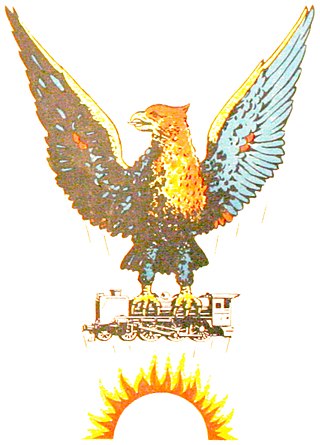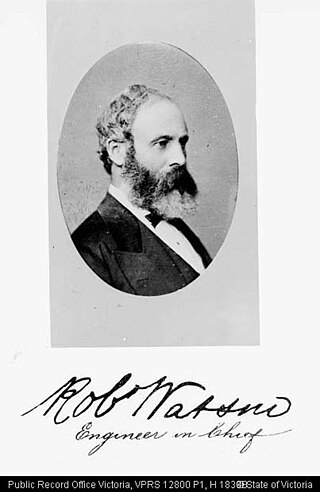
The Williamstown Workshops was the first railway workshop operated by the Victorian Railways, located in the Melbourne inner western suburb of Williamstown.

The Williamstown Workshops was the first railway workshop operated by the Victorian Railways, located in the Melbourne inner western suburb of Williamstown.
The workshops opened in 1858 in four or five temporary buildings at Point Gellibrand, [1] [2] for the assembly of engines and carriages imported from England for the first government owned railways in the state. Other buildings were soon added, with seven locomotives built there, [3] the first being number 100, a 2-4-0 passenger engine completed in 1872. [4] As early as 1860 plans were made for new workshops but nothing came of these, [3] until the 1880s when railway management described the workshops as inadequate and moves were made for new workshops at Newport. By 1889 the new shops were open, and Williamstown was closed. [5]

Richmond railway station is the junction for the Alamein, Belgrave, Cranbourne, Frankston, Glen Waverley, Lilydale, Pakenham and Sandringham lines in Victoria, Australia. It serves the inner south-eastern Melbourne suburb of Richmond, and it opened on 8 February 1859 as Punt Road. It was renamed Swan Street on 12 December of that year, and renamed Richmond on 1 January 1867.

Newport is a suburb in Melbourne, Victoria, Australia, 10 km (6.2 mi) south-west of Melbourne's Central Business District, located within the City of Hobsons Bay local government area. Newport recorded a population of 13,658 at the 2021 census.

Williamstown is a suburb in Melbourne, Victoria, Australia, 11 km (6.8 mi) south-west of Melbourne's Central Business District, located within the City of Hobsons Bay local government area. Williamstown recorded a population of 14,407 at the 2021 census.

The Williamstown Line is a commuter railway line in the city of Melbourne, Victoria, Australia. Operated by Metro Trains Melbourne, it is the city's third shortest metropolitan railway line at 16.2 kilometres (10.1 mi). The line runs from Flinders Street station in central Melbourne to Williamstown station in the inner west, serving 12 stations via Footscray, Yarraville, and Newport. The line operates for approximately 19 hours a day with 24-hour service available on Friday and Saturday nights. During peak hours, the line operates with headways of up to 20 minutes, ensuring frequent service for commuters. During off-peak hours, the service intervals are adjusted to provide service every 20–30 minutes, accommodating the lower demand. Trains on the Williamstown Line run with two three-car formations of Comeng, Siemens Nexas, and X'Trapolis 100 trainsets.

The Deniliquin and Moama Railway Company was a railway company formed by a syndicate of Victorian capitalists to construct a railway from Moama to Deniliquin in New South Wales, Australia.

The Wonthaggi railway line is a closed railway line located in South Gippsland, Victoria, Australia. Its primary purpose was to serve the State Coal Mine but the line also provided passenger and general goods services. The line was opened in 1910 and closed in 1978.

The A2 class was an express passenger locomotive that ran on Victorian Railways from 1907 to 1963. A highly successful design entirely the work of Victorian Railways' own design office, its long service life was repeatedly extended as the Great Depression and later World War II delayed the introduction of more modern and powerful replacement locomotives.

The Victorian Railways H class was an express passenger steam locomotive operated by the Victorian Railways from 1941 to 1958. Intended to eliminate the use of double heading A2 class locomotives on The Overland services on the steeply graded Western line to Adelaide, wartime restrictions led to only one locomotive being built. Nicknamed Heavy Harry, H220 was the largest locomotive ever built in Australia and the largest non-articulated steam locomotive to run on Australian railways.

The B class are a class of diesel locomotives built by Clyde Engineering, Granville for the Victorian Railways in 1952–1953. Ordered and operated by the Victorian Railways, they initiated the dieselisation of the system and saw use on both passenger and freight services, with many remaining in service today, both in preserved and revenue service. Some were rebuilt as the V/Line A class, while others have been scrapped.

The Newport Railway Workshops is a facility in the Melbourne suburb of Newport, Australia, that builds, maintains and refurbishes railway rollingstock. It is located between the Williamstown and Werribee railway lines.

Operation Phoenix was a post-World War II rehabilitation program carried out by the Victorian Railways (VR) in Australia. The program commenced in 1950 and was originally planned to take 10 years and cost £80 million pounds. Operation Phoenix was named after the bird from Egyptian mythology.
The 1922 Border Railways Acts, were Acts passed by the Parliaments of both Victoria and New South Wales, which authorised the construction of cross border railways in the Riverina region of Australia. Despite being located in New South Wales, the region was closer economically to Victoria and its railway network, operated by Victorian Railways. Another complication was that Victorian Railways used the 1,600 mm broad gauge, while the New South Wales Government Railways used 1,435 mm standard gauge.
Ballarat North Workshops is a railway engineering facility in Ballarat, Victoria, Australia. It occupies 5.5 hectares of land beside the junction of the Mildura and Serviceton railway lines.
The Phoenix Foundry was a company that built steam locomotives and other industrial machinery in the city of Ballarat, Victoria, Australia. Over 30 years they built 352 locomotives for the Victorian Railways, of 38 different designs.
Bendigo Workshops is a railway workshop in Bendigo, Victoria, Australia. It is located in the north of the city beside the junction of the Yungera and Deniliquin railway lines. The site covers 10.3 hectares of land and has 31 separate buildings, including a 10,000 sqm main workshop building and six kilometres of railway track.

Jolimont Workshops was a railway workshop operated by the Victorian Railways beside Jolimont Yard, near the Melbourne CBD, Australia. Opened in 1917 and dedicated to the maintenance and repair of electric multiple units and locomotives, it was the first part of the yard to be closed and relocated, with demolition completed in 1994. The site is now part of the Melbourne Park tennis complex.

The Victorian Railways E class was a class of electric locomotive that ran on the Victorian Railways (VR) from 1923 until 1984. Introduced shortly after the electrification of the suburban rail system in Melbourne, Australia, and based on the same electrical and traction equipment as Melbourne's early suburban electric multiple unit fleet, they provided power for suburban goods services and shunting for six decades.
North Melbourne Locomotive Depot was the main location for maintenance of the Victorian Railways steam locomotive fleet based in Melbourne. Located in the middle of the Melbourne Yard precinct in the suburb West Melbourne near North Melbourne station, the site is now occupied by the Melbourne Steel Terminal. The depot was described by railway employees as "the hub of the universe", "the VR's nearest approach to Dante's Inferno", or "the Black Hole of Calcutta" depending on their disposition.

Robert Watson was an English and Australian civil engineer. He was also a surveyor and railway engineer.
William Elsdon was an English civil engineer. He was also an architect and railway engineer who worked predominantly on early railways in Victoria, Australia.